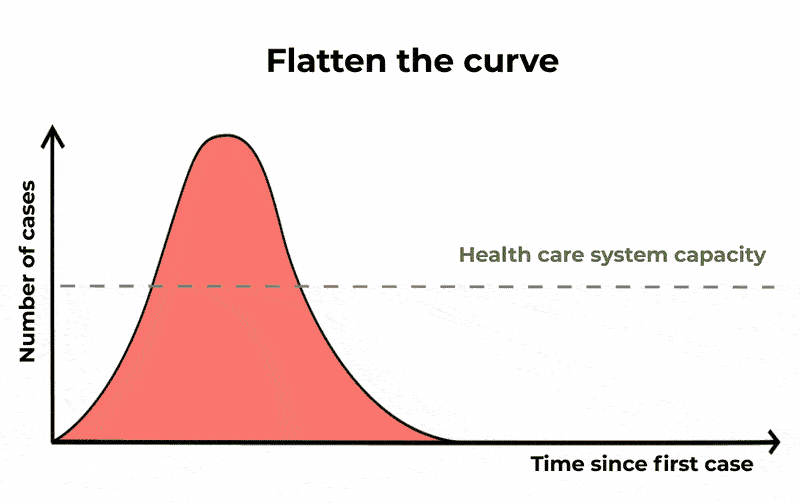Make the016.com a preferred choice with Google by clicking here 
 U.S. Army soldiers work to set up a field hospital inside CenturyLink Field Event Center in Seattle. AP Photo/Elaine Thompson
U.S. Army soldiers work to set up a field hospital inside CenturyLink Field Event Center in Seattle. AP Photo/Elaine Thompson
Andrew D. Hwang, College of the Holy Cross
In the U.S., scientists stress that the number of coronavirus cases has been growing exponentially. In ordinary speech, the term “exponential” usually means “really fast.”
To mathematicians like myself, and to scientists and public health officials, the term has a precise and subtly different meaning: A quantity is “exponential” if its rate of change at each point is proportional to the current size.
Let’s explore why the difference matters, and how exponential processes can mislead our perception of risk.
When an exponential quantity is small, its change is slight; when the quantity is large, the change is rapid. Thanks to exponential growth, epidemics start slowly, then balloon with surprising speed.
This pattern presents a distinctive challenge. People intuitively underestimate exponential growth. By the time individuals sense their peril and act, the damage has been multiplied many-fold.
In an epidemic, numerical data and mathematical models are like night-vision goggles, illuminating what cannot be directly perceived.
To a good approximation, viruses spread exponentially in unexposed populations. Each infected individual meets others at random. At each meeting, there is some chance of the virus being transmitted.
The number of new cases in a one-day period – the rate of increase of infection, in individuals per day – is proportional to the number currently infected.
Exponential quantities have a characteristic interval over which the quantity doubles. For illustration, consider an epidemic that doubles daily. If one person is infected today, two are infected tomorrow, four the day after tomorrow, eight the day after that, then 16, 32, 64. After one week, 128. Three days after that, 1,024 are infected.
Let’s flag two items about this example.
First, the number of new cases tomorrow equals the total number of cases today.
Second, 10 doublings, here 10 days, gives a thousand-fold increase in cases.
How many doublings give a million-fold increase? A million is a thousand thousand. It takes 10 doublings for 1,000 to become 1,000,000, 20 days total.
This percentage growth is constant, one doubling per day. In absolute numbers, however, an initial trickle grows rapidly into an uncontrollable flood.
In an epidemic, early action saves lives. Conversely, delay in public health response inflates case numbers exponentially.
The Centers for Disease Control and Prevention and World Health Organization had flagged the coronavirus as a U.S. public health concern by Jan. 21. At that time, there were only a few confirmed U.S. cases. Isolation of the infected and monitoring of their social contacts was technically feasible. Aggressive testing could have better revealed the true number and locations of cases.
Though testing in the first half of March was mostly confined to individuals needing hospitalization, even those numbers show the coronavirus doubling time in the U.S. was at most two and a half days.
Under these conditions, each eight-day delay in public health response translates into roughly 10 times as many cases and deaths as immediate action.
 Flattening the curve is another way of saying buying more time.
Flattening the curve is another way of saying buying more time.
An exponential quantity is characterized by its starting value and its doubling time. By waiting until mid-March to act as a nation, the U.S. lost control over the starting value.
At any stage, however, people can collectively help lengthen the doubling time. Personal hygiene and social distancing effectively reduce viral transmission. Slowing the epidemic “flattens the curve.” The goal is to reduce the maximum number who are hospitalized at any given time and avoid overwhelming the medical system.
There are at least two civic lessons.
We citizens must recognize and respect the creeping-to-explosive nature of exponential growth. Epidemics start small and slowly. The CDC is equipped to detect potential outbreaks in early stages, but it needs the backing of government and the public to fulfill its mission.
Second, we must understand that the public health system undercuts its own public reputation by succeeding. When an epidemic is halted in its early stages, the public seldom knows. The enormous invisible benefits of public health take the form of averted disaster.
[Get facts about coronavirus and the latest research. Sign up for our newsletter.]<!-- Below is The Conversation's page counter tag. Please DO NOT REMOVE. -->![]() <!-- End of code. If you don't see any code above, please get new code from the Advanced tab after you click the republish button. The page counter does not collect any personal data. More info: https://theconversation.com/republishing-guidelines -->
<!-- End of code. If you don't see any code above, please get new code from the Advanced tab after you click the republish button. The page counter does not collect any personal data. More info: https://theconversation.com/republishing-guidelines -->
Andrew D. Hwang, Associate Professor of Mathematics, College of the Holy Cross
This article is republished from The Conversation under a Creative Commons license. Read the original article.
In The News
>WEATHER: Mark Rosenthal's 7-day forecast (1:19). High of 37 today in Worcester
-Bundle up: Worcester area to get cold blast from the polar vortex
>TOP OF THE NEWS
-Worcester honors 6 firefighters who died in warehouse fire 26 years ago (:41)
-Final review clears officer in fatal March shooting in Boylston
-I-290 bridge over Lake Quinsigamond set for "massive resurfacing"
-McGovern Liquor Store building in Greendale sold for $1 million
-TODAY! Radio Worcester (8:06): Bank celebrates 1-year anniversary with 10-cent gas promo
-Road closure on Main Street 7 a.m. to 1 p.m. Thursday
-Plans to add bike lanes on Pleasant Street in Worcester
-Museum of Worcester taps arts leader with deep local roots
-T&G Santa's helpers for December 3rd
-Woman charged after allegedly accelerating S.U.V. at ex-husband’s wife in Charlton
-Aislinn Doyle: December 4th School Committee Meeting agenda preview
-Aislinn Doyle: Worcester Public Schools in Brief for November
-Worcester Public Schools Check-in: What families should know by December
>DINING OUT: Worcester restaurant to celebrate fourth anniversary on Saturday
-ICYMI: Worcester remembers 26th anniversary of deadly Cold Storage Warehouse fire
-Mpox cases confirmed in Worcester; 2 patients hospitalized at UMass Memorial
-Worcester pizza shop offers price paid in "Home Alone" 35 years ago
-Sprawling historic building could soon disappear from I-290 landscape
-See the rest of the day's Worcester news
>HOLDEN (brought to you by Lamoureux Ford): Holidays in Holden Friday and Saturday
-Unique Happy Thanksgiving wishes from Lamoureux Ford (:29)
-Holden police introduce new officer, Darian Spencer
>THE BURBS (brought to you by North End Motor Sales): Wild chase through Shrewsbury streets leads to fentanyl bust
-Scottish Highland bull has been on the lam in Uxbridge since August
-Gardner man sentenced to life in prison in 2017 murder
-Leicester woman arrested for violating restraining order at Cumberland Farms
-Worcester Walks: Westborough trails a relief from hectic holidays
-Sculpt Pilates has come to Sutton
-Spruce Street Golf League crowns champions
-Police logs for Shrewsbury, Grafton and Westborough
>BARS & BANDS: The Mayor's Live Music List for Thursday
-The Silverbacks return to rock out at the White Eagle
>SHOWTIME: "A Christmas Carol" gets a new look in Hanover production
-100 FM The Pike (15:21): Worcester's Alicia Witt on her new Christmas album and balancing music and acting
-Last Call: Art DuBois, poet and human services professional
>OPINION: Janice Lindsay: The thread of holiday meaning
-Unity Radio's Unity in the Community (57:21): Pamela Taylor, Realtor
>OBITUARIES: Tribute to Worcester man who passed away at age 100
>SPORTS: Why Patriots are the NFL’s best team despite easy schedule
-Patriots' Kraft, Belichick among Hall of Fame finalists
-NFL Week 14 schedule, TV and announcers
-Holy Cross men’s basketball cruises to home victory against Northeastern
-Holy Cross women's basketball falls to Harvard
-Holy Cross football team adds 10 during early signing period
-West Boylston primed for trip to Gillette Stadium to play in fourth straight Super Bowl
>NATIONAL: Florida speedboat crash leaves 3 Mainers dead
-America's most-used password in 2025 is one word
-Tragic: Parents accused of cutting baby out of daughter's womb
>NEW ENGLAND: Brian Walshe murder trial Day 3 analysis (29:45)
-Search resumes for man seen clinging to side of boat in Merrimack River
>COLLEGES: Holy Cross Professor Playlists: André Isaacs
-Worcester State's Juan Davila is charting a path from Worcester to the world
-UMass Medical School students build equity, health and community at Worcester Earn-A-Bike
>TRAVEL (brought to you by Fuller RV & Rental): 6 island getaways that won’t break the bank
-Escape to a Winter wonderland at Banff’s Sunshine Mountain Lodge
>BUSINESS: Saint-Gobain opens doors to new Worcester headquarters building
-How's the economy? Let W.B.J. know by taking the 2026 Economic Forecast survey
-LPL Financial Research: More keys for markets in 2026. LPL market outlook sneak peek
-Private employers cut 32,000 jobs last month – hiking odds of interest rate cut
>SHOPPING: A budget-friendly holiday. Managing gift expectations
>HEALTH: W.H.O. warns backsliding on measles elimination as coverage falls
-7 deaths, more than 700 serious injuries linked with diabetes glucose monitor errors
>HOMES: Can you afford a "starter home" in the Boston area? Housing report says only 15% of renters make enough
>FOOD: Ocean Spray investigating water-filled cranberry sauce cans
>TV/STREAMING: Trailer for new Netflix doc, "The New Yorker at 100" (2:14)
>MOVIES: The 100 best comedy movies of all time: Critics' pick
>CELEBRITY: Beloved HGTV star Hilary Farr breaks silence on "devastating" health rumors
>ANIMALS: Cat who can’t groom himself falls asleep during bath time (1:32)
>HISTORY: Author James Patterson makes bombshell claim about Marilyn Monroe's death
>GOOD NEWS: Army veteran, double amputee sets several world records
-Meanwhile, in New Jersey, Christmas tree farm ripped for selling "horrific" spray-painted firs
Latest obituaries | | Wednesday's Highlights | | Today's horoscope | | Local Sports
Quick Links: Personalize your news | | Browse members | | Advertise | | Blogs | | Invite friends | | Videos
Animals | | Boston Sports | | Business | | Cars | | Celebrity | | Colleges | | Commute & Travel | | Crime | | Faith | | Food | | Good News | | Health | | Help Wanted | History | | Homes | | Local Sports | | Lottery | | Movies | | National | | New England | | Politics | | Shopping & Deals | | SHOWTIME! | | TV & Streaming | | Weather